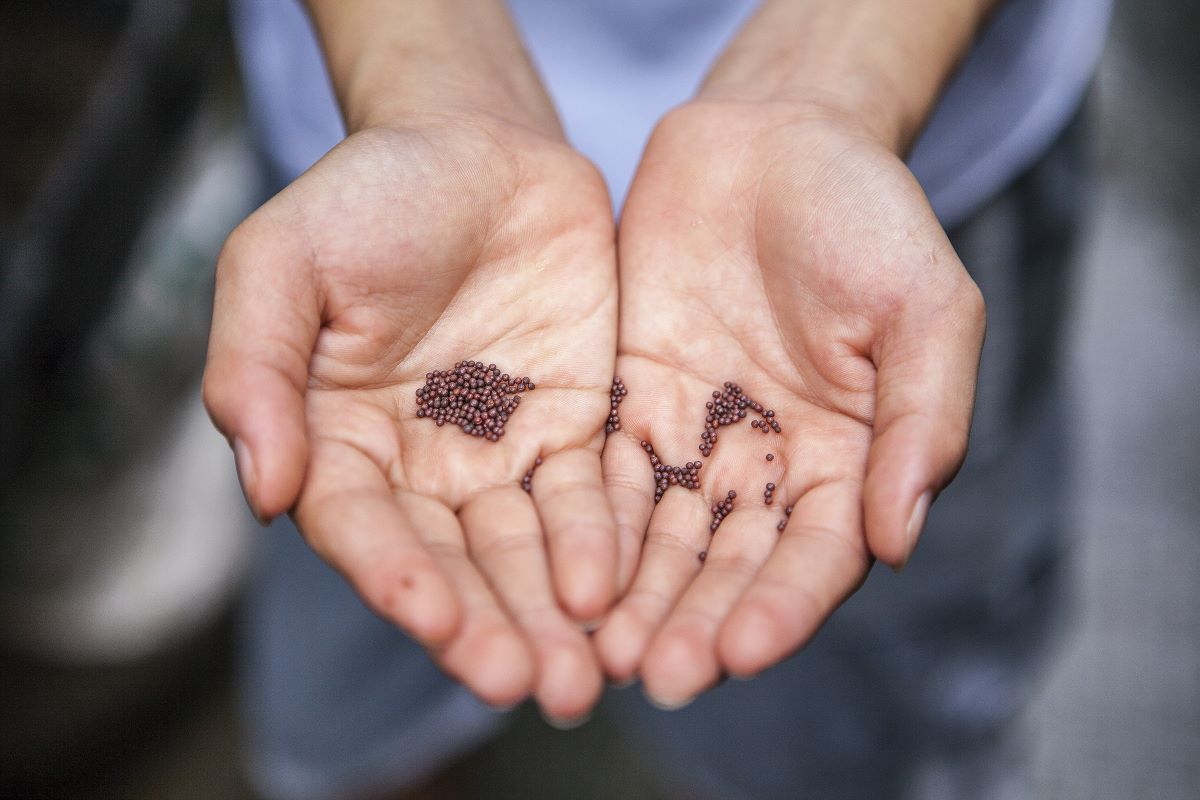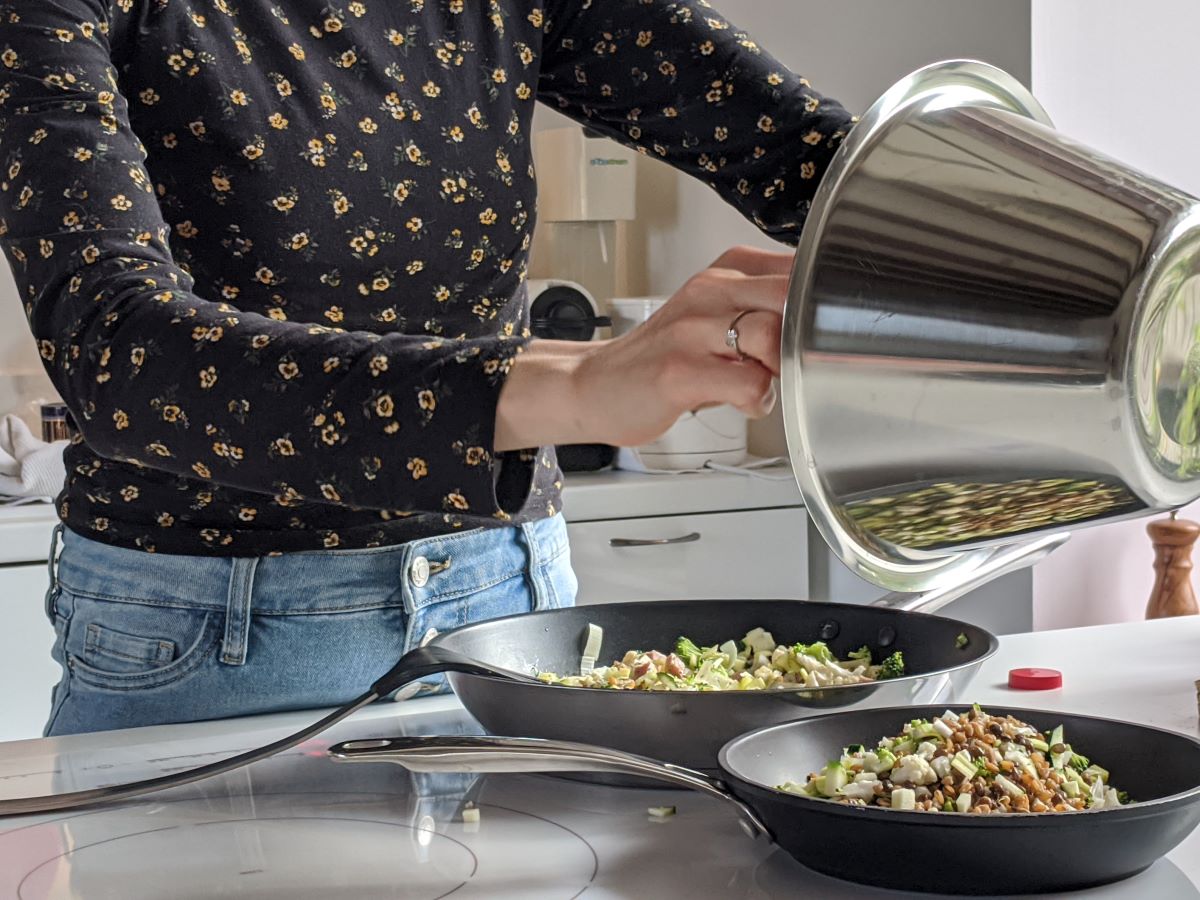Sometimes life can feel a little like there are secrets, life hacks, that when you learn them, you wonder why no one ever told you about them before. Seed cycling is one of those life secrets.
Maybe you’ve heard of seed cycling. It’s a topic that comes up periodically in wellness circles on occasion, and perhaps a little more frequently in women-centered wellness circles, such as midwifery and similar groups where women’s hormonal wellness is more openly discussed. But even if you’ve heard of it, you might not know what it is, how to do it, or what the benefits are.
If you’ve ever wondered about seed cycling, (or if you haven’t heard of it but are looking for gentle, natural, and affordable ways to start managing your hormones in your own kitchen), this deep dive will help answer some of the most common questions about the subject.

What Is Seed Cycling
Seed cycling is actually not complicated and is exactly what it sounds like—the process of cycling through seeds. But that’s pretty basic, so let’s take a closer look.
More specifically, seed cycling is the process of cycling through certain types of seeds alongside your monthly cycle to support hormone production and balance to support your overall bodily functions. In other words, you consume specific types of seeds throughout specific phases of your monthly cycle.
The practice isn’t new, and women of all ages can use seed cycling to support their body’s hormones. Supporting your hormones sounds like a broad statement because our hormones control so much of our bodily functions. But as a simple and direct result, the practice can have some very specific and tangible benefits.
Read More: Chart Topping Hits (AKA: Charting Your Cycle)

Reported Benefits of Seed Cycling
The benefits of seed cycling can vary from person to person, but here is just a short list of commonly reported benefits from women. It’s worth noting that you may find some of this online if you do some research on the subject, but you’re likely to find a considerably more substantial amount of personal testimony in circles where those conversations are openly held. (You may look to online communities like Facebook groups or accounts on Instagram or hashtags on Twitter that are women-led and centered around women’s wellness.)
- Perhaps the broadest benefit of seed cycling is that it supports your monthly cycle. Your monthly cycle is comprised of four phases (menstrual, follicular, ovulatory, and luteal), and each is accompanied by changes in your hormones and, consequently, energy levels. By generally supporting these changes (which happen on a roughly weekly basis in a typical 28-day cycle), you can support your body at the hormonal level. And since hormones are largely in charge of much of our perceived mental, emotional, and physical wellness, that’s a significant benefit.
- To say that your hormones are in charge of your mental, emotional, and physical wellness is accurate but doesn’t capture the real depth of that concept. When seed cycling to support hormonal health, you are adding to your diet seeds (which we’ll go over in more detail below) that directly balance and support estrogen, progesterone, and testosterone production in the body.
These hormones are responsible for the production and release of other hormones, such as serotonin (the happy hormone that triggers joy and satisfaction, and reduces/prevents depression), melatonin (the sleep hormone that helps you maintain restful and restorative sleep, wherein your body can heal and recover at the cellular level), just to name a few.
They also aid in mental clarity. Out-of-balance hormones can lead to brain fog (which is one of the earliest symptoms of possible thyroid disorders) and a need/want for caffeine to feel awake and alert throughout the day.
And of course, our hormones affect our physical performance. This includes everything from physical sex drive to athletic and fitness performance, which again, includes a vast amount of our daily activities.
- In correlation with the above effects, seed cycling (and the consequential support of your hormones) is often reported to reduce symptoms of PMS, including cramping, bloating, tenderness, hormonal acne, and more.
- And last but not least, seed cycling can impact your fertility. Because fertility is directly tied to your hormones (and estrogen and progesterone are specifically and closely tied to pregnancy, your period, and everything in between), it goes without saying that supported and balanced hormones will lead to a body that is more equipped and prepared to grow a new life.
Read More: How Period Panties Changed the Conversation About Women’s Health

The Seeds You Need
So now you know the benefits and basic concept of seed cycling. To start the process of seed cycling, you only need four ingredients: pumpkin, flax, sesame, and sunflower.
- Pumpkin seeds are high in healthy fats, magnesium, and iron, all great for supporting your body through and immediately after your period.
- Flax seeds are high in fiber, which supports healthy digestion and aids the body in processing excess hormones.
- Sesame seeds are also high in healthy fats, protein, vitamins, and minerals helping with blood sugar control and inflammation.
- Sunflower seeds are high in vitamins and minerals that aid in supporting your immune system.
Because you are consuming the seeds with the intention of supporting your monthly cycle and hormones, it is important to note that the quality of your seeds matters. Seed cycling with organic seeds is highly recommended, as the last thing you want is to introduce additional toxins or residual pesticides or processed oils into your body in the form of what should be a highly nutritious supplement.
Read More: Popular Supplements for Women That Boost Health And Wellness

How to Seed Cycle
Once you have your seeds, you’ll need to cycle through them in a specific combination and pattern. But don’t worry! It’s really easy.
The first thing you want to do is to grind your seeds. You want to buy them whole so that all the nutritional value is still intact, but you need to grind them before consuming them to optimize their form for easy processing. Your body can more readily access the nutrients the seeds offer when they are freshly ground.
(You can definitely prep your seeds for a full month at a time and still retain their nutritional value. No need to grind them fresh daily unless that’s just something you enjoy doing.)
In weeks one and two of your cycle (menstruation and follicular—basically from day one of your period until you ovulate) you’ll consume pumpkin and flax seeds to support estrogen production and balance. In weeks three and four (the ovulatory and luteal phases—from ovulation until the first day of your next period) you’ll consume sunflower and sesame seeds to support testosterone production and balance.
It’s that simple. But there are a few tips to be mindful of.
First, the recommended serving is one to two tablespoons of each seed type. You’ll need to determine what amount works for you. It’s also key to not mix your ground seeds prior to serving, as you won’t know exactly how much of each type you’re actually getting per serving.
Second, be intentional with how you plan to eat your seeds daily. This is a new habit you’re forming, and it’s not as simple as swallowing a capsule with a glass of water. You’re welcome to chow down on tablespoons of freshly ground seeds on their own, but that sounds rather dry. Instead, make plans (and buy groceries to support those plans) to eat your seeds with some Greek yogurt and berries, or a small serving of cottage cheese, or mixed into your oatmeal, smoothie, or another snack of your choice. The point is, have a plan so that you’ll actually eat your seeds!
And third, know that as with all supplements and nutritional changes, it takes time. There are plenty of reports of women noticing major changes in their mood, period, and other phases of their cycle within as little as three weeks. For others, one to two months might be the window of difference. Because everybody is different, every result will be too. Be patient and consistent though, and the changes will come.
Read More: Benefits of 32 of BEST Vitamins and Supplements Explained
Seed cycling is a powerful and simple tool to use to help take control of your hormonal and cyclical wellness. The benefits are nearly endless as your hormones affect so much of your total wellness, and the risks are really none. (Because seeds are gentle and completely natural food, they are safe for women of all ages, including pregnant or breastfeeding women, although the benefits may vary for pregnant/ breastfeeding women due to completely different hormonal changes, and pregnant or breastfeeding women may still want to check with their doctors to ensure seed cycling is safe for them.)
With much to gain and nothing to lose, seed cycling is totally accessible and a great way to make dynamic changes in your health. What better time than now to get started on your seed cycling journey?
WANT TO READ MORE?
Check out Daily Mom’s Healthy Living Section for more advice, tips, and tricks.
CONNECT WITH DAILY MOM
💖 NEWSLETTER: DAILY READS IN YOUR INBOX 💖
Sign up to receive our picks for the best things to do, see and buy so you can relax and focus on more important tasks! Let us help you be the best version of yourself you can be!
BE SOCIAL WITH US
📌 LOVE IT? PIN IT!📌











































